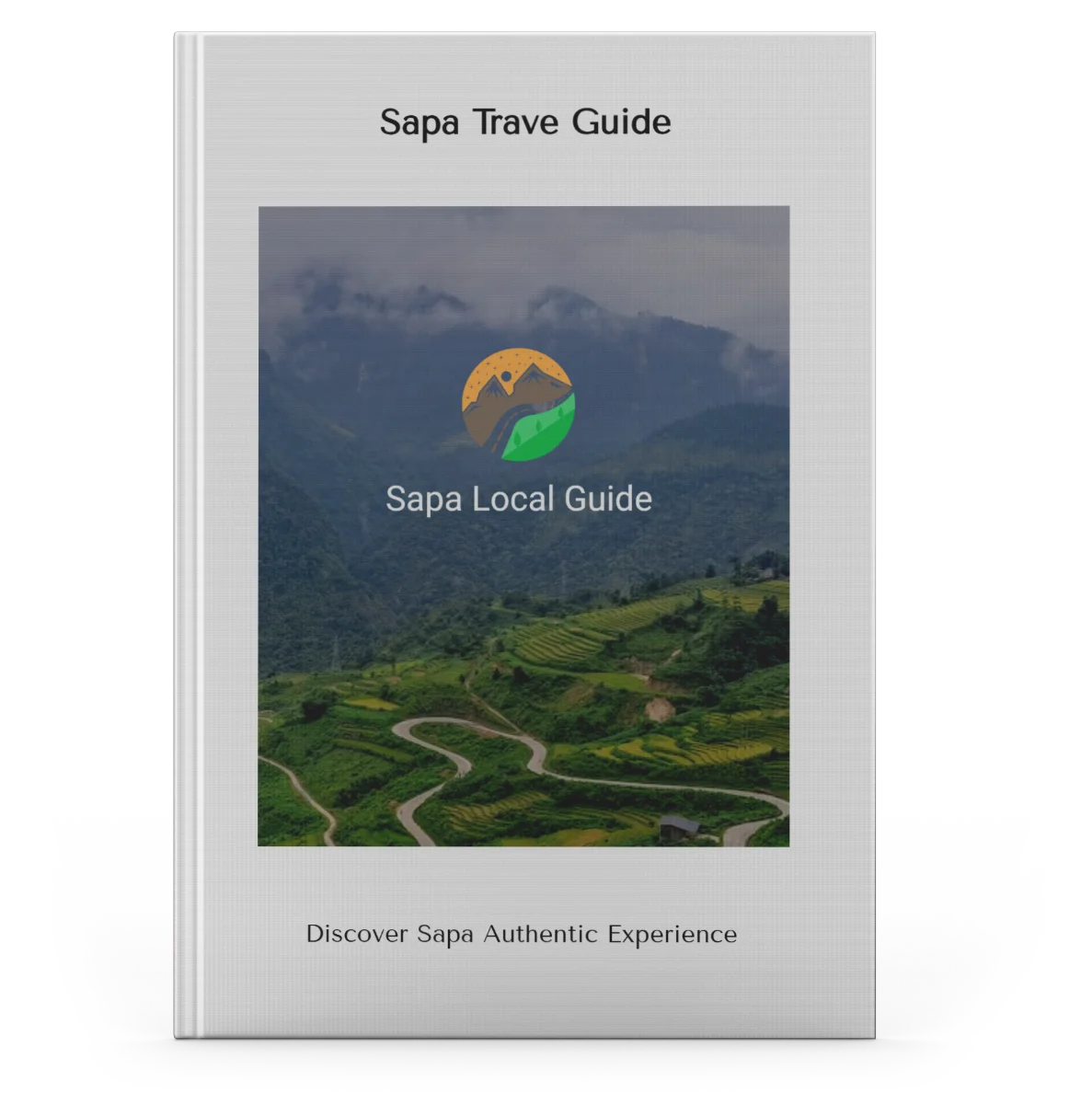![]()
Authentic Experience of Sapa
Cat Cat Village – A cultural village in Northwest Sapa with traditional terraced fields and a unique heritage of local ethnic groups.

Cat Cat Village Sapa is an ancient village famous for its unique and peaceful beauty created by the Black Hmong people. Located in the middle of the vast Northwest mountains and forests, this place has long been a “village worth living” and also an ideal tourist destination for domestic and foreign tourists. Let's explore with Sapa Local Guide the interesting information of Cat Cat village when traveling to Sapa in the content below!
Cat Cat Village is one of the most popular tourist spots in Sapa 1 today tour. It is located at the foot of the grand Hoang Lien Son mountain range, about 5 – 6 hours from Hanoi by highway. From Sapa town, it's just 2 kilometers to reach Cat Cat Village.
Cat Cat Village is Sapa Local Guide Tour Best Views is like a hidden treasure in Sapa. It attracts visitors with its beautiful natural scenery and the rich culture of the Hmong people. You will see large mountains, sparkling waterfalls, and cool streams flowing through the village. The old houses made of wood, built hundreds of years ago, give the village a special charm, making it feel close to nature.
The name “Cat Cat” is said to come from the H'Mong language, meaning “under the market,” referring to a waterfall under the market. Another story says that when the French discovered this place, they were amazed by a beautiful waterfall. In French, “waterfall” is called “cascade,” which sounds like “cat cat.” Since then, the village has been called Cat Cat.
When you visit, you can enjoy the sights of terraced fields during the rice season and flowers blooming in spring. You can also join in the cultural activities of the Hmong people, adding to the charm of your experience

Cat Cat Village in Sapa has cool weather and its own beauty in every season. According to visitors and locals, the best time to visit is from April to October. During this time, the weather is mild, with little rain, making it easier to travel. Also, many traditional Hmong festivals happen, like the Long Tong festival and Gau Tao festival. You can learn about the H’Mong culture and customs.
If you want to avoid the busy tourist season, you can visit Cat Cat Village in winter (from November to March). The weather is cold, but you can still enjoy the beautiful scenery of the Northwest mountains and the peaceful, fresh air of the village.
=>Read more about The best time to visit Sapa Here.
To have a smooth tour with the most complete emotions at Cat Cat village, Sapa Vietnam, don't miss the important information of Sapa Local Guide below!
Cat Cat Village is a famous old village, established in the 19th century. To get there, first, you need to travel to Sapa town center. From Sapa market, head southwest on Luong Dinh Cua Street. Then, turn onto Xuan Vien Street from Dien Bien Phu Street. Continue on to Fansipan Street, and follow this road until you reach Cat Cat Village.
The route from Sapa market to Cat Cat Village is about 2-3 km long, with paved roads that are easy to travel. Visitors won’t feel tired or uncomfortable. You can reach the village by different means, like motorbike, bicycle, or even walking. If you travel by motorbike, you can park at the village entrance for 10,000 VND per bike.
To explore and enjoy the unique local culture in Cat Cat Village, you need to buy an entrance ticket. The latest ticket prices vary by age:
Please note, this is just the entrance fee. Other costs like hiring a guide, renting transportation, or buying handmade items are not included.
Visitors often ask, “What time does Cat Cat Village close?” The village is open from 5 AM to 10 PM. However, it's best to leave before dark to avoid the cold night fog and stay safe. If you want to stay overnight, you can rent a homestay or hotel in the village.
When visiting Cat Cat Village, wear comfortable clothes suitable for the weather. Keep in mind, you’ll walk a long way from the ticket checkpoint to the village. So, choose comfortable clothing and shoes for easy movement.
Also, bring a hat, sunglasses, and sunscreen to protect yourself from the sun. Check the weather forecast and carry a windbreaker or raincoat if needed.
If you want to dress like the Hmong people, you can rent traditional outfits near the village gate. The cost is around 150,000 VND to 300,000 VND per set.

Besides the natural scenery, Catcat Village in Sapa also attracts tourists with the long-standing traditional culture of the H'Mong people. So, what makes Black Hmong culture in Catcat Village special? Let's explore the interesting cultural experiences awaiting you here!
Along with tourism, Catcat Village continues to preserve and develop its long-standing traditional crafts, which form a unique part of the local culture. When visiting, you can easily stop by the craft workshops to learn about various handicrafts like:
Stone rolling – Linen weaving
Linen weaving is an ancient craft of the Black Hmong people. At the end of summer and beginning of fall, locals harvest and dry flax plants. The plants are then stripped into small fibers, and these fibers are rolled with a stone several times to soften them. Only then are the fibers ready for weaving into fabric.

Drawing with beeswax on traditional clothing
In making traditional clothes, drawing patterns with beeswax is a complex step. It requires a lot of skill, patience, and care. The artist uses a pen made of bamboo or wood. The pen tip is dipped in melted beeswax and drawn onto the fabric. After the drawing is done, the fabric is dyed and left to dry.
The beeswax patterns on traditional Hmong clothing are very diverse. They are inspired by nature, daily life, and Hmong beliefs. Some common patterns include flowers, animals, the sun, the moon, mountains, and rivers.
There are other crafts here too, like basket weaving, brocade making, and silver crafting. When visiting Cat Cat Village, tourists can watch the local people working and even join in to experience these traditional crafts. It’s really exciting, isn’t it?
When visiting Catcat Village, you can experience the unique culture of the Hmong people. You'll have the chance to join in lively music events, enjoy beautiful dances, and listen to soothing folk songs. Don't miss the chance to try the traditional Bamboo Dance, a fun and special activity of the local people!
If you visit Catcat Village at the start of the year, you can join the Gâu Tào Festival, one of the biggest festivals of the Black Hmong people. This festival is held to pray for blessings, good fortune, and a peaceful new year with good weather.
The Gâu Tào Festival is an important cultural event that takes place from the 1st to the 15th of the Lunar New Year. If it’s held over three consecutive years, each year has three festival days. Otherwise, it can be held in one year for nine days. Besides the rituals, the festival shows the rich cultural identity of the Black Hmong people. The goal is to pray for health, peace, prosperity, and a good harvest. It’s also a special time for people to come together after a year of hard work.
In recent years, the local government has started special cultural programs to promote tourism. These include events like “Black Hmong Cultural Festival in Cat Cat Village” and “A Day as an Hmong Bride.” When joining these programs, visitors can experience the daily life of the Hmong people, enjoy traditional dances, and play folk games.

Earthen wall houses are built using soil and gravel following the traditional techniques of local ethnic people in villages. These houses stay cool in summer and warm in winter, making them perfect for the northern mountainous climate.
Unlike the earthen houses of the Dao, Ha Nhi, Tay, and others, the earthen houses of the Black Hmong people in Catcat Village, Sapa, are usually surrounded by stone fences made from rough mountain stones without any smoothing or adhesive. The stone walls, about waist-high, separate the living area from the surrounding fields. Next to the fence is the entrance, with a tall wooden gate and a pretty roof.
These houses in Sapa have unique features that carry deep cultural meanings. Their foundation is strong, built without using columns or posts, showing the builder's skill and determination. The house has three sections, each with its own purpose: the left side for the owner’s stove and sleeping area, the right side for a heating stove and guest bed, and the largest middle section for ancestor worship and guest reception, creating a space for family gatherings.
In spring, blooming peach and plum flowers brighten up these houses, creating a simple yet beautiful scene that symbolizes prosperity and happiness for the ethnic community in Sapa's mountains.
Along with its unique culture, the natural beauty and local Black Hmong dishes of Catcat Village in Sapa also keep tourists coming back. When visiting, you cannot miss these exciting experiences.
Tien Sa Waterfall, also known as Catcat Waterfall, is a famous tourist spot in Catcat Village. The waterfall originates from the Hoang Lien Son mountain range and Tien Stream. As the water flows down the falls, it creates a peaceful and romantic scene. Standing at the base of Tien Sa Waterfall, visitors not only enjoy the stunning natural beauty but are also mesmerized by the sound of rushing water.
Watching the gentle flow of water falling from the waterfall brings a sense of calm and relaxation amidst the mountains of the Northwest. This beauty has inspired legends about fairies coming down to bathe in Tien Sa Waterfall. Though the truth about these fairies remains a mystery, these stories honor the beauty of the waterfall and add to its charm and mystery.

The water season happens in April and May when people flood the fields to prepare for planting. The terraced fields look like large silver mirrors, reflecting the sunlight beautifully.
In contrast, during the rice harvest in August and September, visitors can see the fields turn bright yellow as the rice ripens

Known as the “most beautiful village in Northwest Vietnam,” Catcat Village is a perfect place for photo lovers. It’s a spot where visitors can capture their best pictures. To make your experience even more fun, you can rent traditional outfits at the village entrance and take photos by the terraced fields, old rose gardens, bird nests, giant water wheels, and wooden bridges.
When visiting Catcat Village, you must try the traditional dishes of the Blacl Hmong people. Their food is very diverse, with favorites like corn wine, dried meat called “Khăng Gai,” chicken blood pudding, and corn cakes. Besides these, dishes like thắng cố and fermented tofu attract many visitors because of their unique preparation and taste.
This is all the important information about Catcat Village in Sapa that you should know for a memorable trip. Aside from Catcat, Sapa has many other interesting places to explore with special experiences. To keep discovering this beautiful travel destination and more exciting spots across Vietnam, don’t forget to follow and read Sapa Local Guide’s upcoming posts
=>Visit More Villages in Sapa
Sapa 1 Day

1 day experience,Rice fields, valley, villages. Moderate to challenging, Private,Vegan-friendlyCultural immersion & active adventure
Motorbike Tour

1 day experience,Rice fields,waterfall.Challenging,Private tours friendly Cultural immersion, active adventure
Sapa 2 Days

2 days 1 night experience. Moderate to challenging, adventure. Mountains, valleys, rice fields and villages. Vegan-friendly
Sapa 3 Days

3 days 2 night experienc, Moderate to challenging. Mountains, valley, rice fields & villages. Private tours. Vegan-friendly
Complete with itinerary, destinations, food, accommodation and tips!
